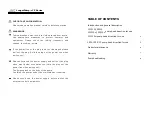
FFT
R&S
®
RTM20xx
114
User Manual 1317.4726.02 ─ 01
d) Turn the vertical SCALE rotary knob to define the scaling of the FFT amplitudes.
Turn the knob counter-clockwise to decrease the amplitudes, or clockwise to
enlarge them.
To configure the Y(t)-window numerically
Alternatively to configuring the Y(t)-window numerically via the softkeys, you can use the
rotary knobs to change the settings graphically, see
"To configure the Y(t)-window graph-
1. Press "Y(t)-Setup" in the "FFT" menu.
2. Press "Y-Scale" to define the scaling of the signal amplitudes in the Y(t)-window.
3. Press "Y-Position" to define the vertical position of the time axis in the Y(t)-window,
in divisions.
4. Press "Main Time Base" to define the scaling for the time base in the Y(t)-window in
seconds per division.
Note that when you change the scaling for the main time base, the width of the FFT
time base extract is also changed.
5. Press "Trigger Offset" to define the offset of the trigger point to the reference point
for 0s.
Note that when you change the trigger offset, the position of the FFT time base extract
is also changed.
The scaling factor for the time base (TB) and the trigger offset (T) are indicated in the
information bar above the Y(t)-window.
Fig. 8-2: Time base (per division) and trigger offset in Y(t)-window
To configure the Y(t)-window graphically
1. Press the horizontal SCALE rotary knob to select the Y(t)-window ("TB"/"T" settings
are highlighted).
2. Turn the vertical SCALE rotary knob to define the scaling of the signal amplitudes in
the Y(t)-window. Turn the knob counter-clockwise to decrease the amplitudes, or
clockwise to enlarge them.
Configuring and Using FFT Calculations
















































